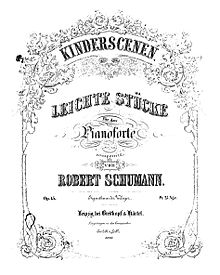music.wikisort.org - Composition
Kinderszenen[lower-alpha 1] (German pronunciation: [ˈkɪndɐˌst͡seːnən], "Scenes from Childhood"), Op. 15, by Robert Schumann, is a set of thirteen pieces of music for piano written in 1838.
| Kinderszenen | |
|---|---|
| by Robert Schumann | |
 First edition title page | |
| English | Scenes from Childhood |
| Opus | 15 |
| Period | Romantic period |
| Composed | 1838 |
| Movements | 13 pieces |
| Scoring | Solo piano |
History and description
Schumann wrote 30 movements for this work but chose 13 for the final version. The unused movements were later published in Bunte Blätter, Op. 99, and Albumblätter, Op. 124.[1] Schumann initially intended to publish Kinderszenen together with Novelletten (Opus 21); the shared literary theme is suggested by the original title Kindergeschichten (Children's Tales). He told his wife Clara that the "thirty small, droll things", most of them less than a page in length, were inspired by her comment that he sometimes seemed "like a child". He described them in 1840 as "more cheerful, gentler, more melodic" than his earlier works.[2]
Movement No. 7 of the work, Träumerei, is one of Schumann's best known pieces; it is the opening and closing musical theme of the 1947 Hollywood film Song of Love,[3] and Träumerei is the title of a 1944 German biographical film on Schumann.[4] In Russia, a hummed choral a cappella version became known as mourning music, being played annually during the Minute of Silence on Victory Day.[5] In 2021, violinist Fenella Humphreys released an arrangement of Träumerei for violin.[6]
Originally called Leichte Stücke ("Easy Pieces"), the section titles were only added after the completion of the composition, and Schumann described them as "nothing more than delicate hints for execution and interpretation".[7] Timothy D. Taylor, however, has discussed the choice of titles for this work in the context of the changing situation of music culturally and economically, stating that the final movement, entitled Der Dichter spricht (The Poet Speaks), marked a realisation among composers that, due to the decline of patronage structures in the 19th century, their musical works must take on new meanings.[8]
There is no known complete manuscript of Kinderszenen.[9]
Pieces
| Title | Key | Play |
|---|---|---|
| 1. Von fremden Ländern und Menschen Of Foreign Lands and Peoples |
G major | |
| 2. Kuriose Geschichte A Curious Story[lower-alpha 2] |
D major | |
| 3. Hasche-Mann Blind Man's Bluff |
B minor | |
| 4. Bittendes Kind Pleading Child |
D major | |
| 5. Glückes genug Happy Enough |
D major | |
| 6. Wichtige Begebenheit An Important Event |
A major | |
| 7. Träumerei Dreaming |
F major | |
| 8. Am Kamin At the Fireside[lower-alpha 3] |
F major | |
| 9. Ritter vom Steckenpferd Knight of the Hobbyhorse |
C major | |
| 10. Fast zu ernst Almost Too Serious |
G♯ minor | |
| 11. Fürchtenmachen Frightening |
E minor – G major | |
| 12. Kind im Einschlummern Child Falling Asleep |
E minor - E major | |
| 13. Der Dichter spricht The Poet Speaks |
G major |
Notes
- Original spelling: Kinderscenen
- Original spelling: Curiose Geschichte
- Original spelling: Am Camin
References
- Polansky, Robert (Spring 1978). "The Rejected Kinderscenen of Robert Schumann's Opus 15". Journal of the American Musicological Society. 31 (1): 126–131. doi:10.1525/jams.1978.31.1.03a00070. JSTOR 831388.
- Jensen, Eric Frederick (16 January 2012). Schumann. Oxford University Press. pp. 162–. ISBN 978-0-19-983068-8 – via Google Books.
- "Träumerei" played by Katharine Hepburn in the film Song of Love on YouTube
- Träumerei at IMDb
- Минута молчания памяти павших (1968) [A moment of silence in memory of the fallen] on YouTube
- "Round Revue - Fenella Humphreys - Music for Violin". Round Revue. Retrieved 29 May 2021.
- Thorpe, Day (December 1990). "Music Reviews: Kinderszenen, Op. 15; Album für die Jugend, Op. 68 by Robert Schumann, Otto von Irmer, Walther Lampe". Notes. Second Series. 11 (4): 605–606. doi:10.2307/893060. JSTOR 893060.
- Taylor, Timothy D. (December 1990). "Aesthetic and Cultural Issues in Schumann's Kinderszenen". International Review of the Aesthetics and Sociology of Music. 21 (2): 161–178. doi:10.2307/837021. JSTOR 837021.
- Sams, Eric (1974). "Review: Schuman Scenes – Kinderszenen, Op. 15, by Schumann, Franzpeter Goebels". The Musical Times. 115 (1572): 146. doi:10.2307/955016. JSTOR 955016.
External links
 Media related to Kinderszenen at Wikimedia Commons
Media related to Kinderszenen at Wikimedia Commons- Kinderszenen: Scores at the International Music Score Library Project
- Kinderszenen on YouTube, Cyprien Katsaris
- Kinderszenen on YouTube, Sergey Kuznetsov
- Kinderszenen (Performance) on YouTube, Clifford Curzon
Другой контент может иметь иную лицензию. Перед использованием материалов сайта WikiSort.org внимательно изучите правила лицензирования конкретных элементов наполнения сайта.
WikiSort.org - проект по пересортировке и дополнению контента Википедии